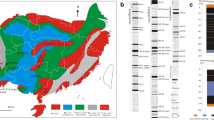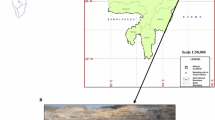Abstract
Mineralogy and geochemistry of the four main workable coal seams (No.6, No.7, No.8, and No.11) of Late Permian age from the Songzao Coalfield, Chongqing, Southwest China, were examined using inductively coupled plasma-mass spectrometry (ICP-MS), X-ray fluorescence spectrometry (XRF), cold-vapor absorption spectrometry (CV-AAS), ion-selective electrode (ISE), scanning electron microscopy equipped with an energy-dispersive X-ray spectrometer (SEM-EDX), and X-ray diffraction analysis (XRD). The results showed that the main workable No.8 Coal that accounts for about 60% of the total coal reserves in the Songzao Coalfield was not enriched in hazardous trace elements. The No.11 Coal has high concentrations of alkaline elements, Be (9.14 μg/g), Sc (12.9 μg/g), Ti (9508 μg/g), Mn (397 μg/g), Co (23.7 μg/g), Cu (108 μg/g), Zn (123 μg/g), Ga (32 μg/g), Zr (1304 μg/g), Nb (169 μg/g), Hf (32.7 μg/g), Ta (11.4 μg/g), W (24.8 μg/g), Hg (0.28 μg/g), Pb (28.1 μg/g), Th (24.1 μg/g), and rare earth elements (509.62 μg/g). The concentration of Nb and Ta in the No. 11 Coal is higher than the industrial grade, and their potential utilization should be further studied. Besides pyrite, quartz, calcite, and clay minerals, trace minerals including chalcopyrite, marcasite, siderite, albite, mixed-layer clay minerals of illite and smectite, monazite, apatite, anatase, chlorite, and gypsum were found in the No.11 Coal. It should be noted that alabandite of hydrothermal origin and anatase occurring as cement were identified in coal. In addition, the clayey microbands derived from alkaline volcanic ashes were identified in the coal. The dominant compositions of these clayey microbands were mixed-layer clay minerals of illite and smectite, which were interlayered with organic bands. The modes of occurrence of alkaline volcanic ash bands indicate that the volcanic activities were characterized by the multiple eruptions, short time interval and small scale for each eruption during peat accumulation. The alkaline volcanic ashes were the dominant factors for the enrichment of alkaline elements, Nb, Ta, Zr, Hf, and rare earth elements, and the sulfide minerals are the main carriers of Ga, Cu, and Hg in the No. 11 Coal.
Similar content being viewed by others
References
Chou C L. Geological factors affecting the abundance, distribution, and speciation of sulfur in coals. In: Yang Q, ed. Geology of Fossil Fuels—Coal. Proceedings of the 30th International Geological Congress, Vol. 18, Part B. The Netherlands, Utrecht: VSP, 1997. 47–57
Bouška V, Pešek J, Sýkorová I. Probable modes of occurrence of chemical elements in coal. Acta Montana, Ser. B. Fuel, Carbon, Mineral Process, Praha, 2000, (10): 53–90
Tang X Y, Huang W H. Trace Elements in Chinese Coals (in Chinese). Beijing: The Commercial Press, 2004. 1–28
Ward C R. Analysis and significance of mineral matter in coal seams. Int J Coal Geol, 2002, 50: 135–168
Wang P, Pan Z L, Weng L B. Systemic Mineralogy (in Chinese). Beijing: Geological Publishing House, 1982. 257–258
Liu Y J, Cao L M. Guidelines of Elemental Geochemistry (in Chinese). Beijing: Geological Publishing House, 1987. 113–137
Querol X, Chinenon S, Lopez-Soler A. Iron sulphide precipitation sequence in Albian coals from the Maestrazgo basin, southeastern Iberian Range, northeastern Spain. Int J Coal Geol, 1989, 11: 171–189
Faraj B S M, Fielding C R, Mackinnon D R. Cleat mineralisation of Upper Permian Baralaba/Rangal Coal Measures, Bowen Basin, Australia. In: Gayer R, Harris I, eds. Coalbed Methane and Coal Geology, Geological Society, London, Special Publication, 1996. 109: 151–164
Dai S F, Ren D Y, Tang Y G. Modes of occurrence of major elements in coal and their study significance. Coal Geol Explor (in Chinese), 2005, 33(2): 1–5
Kortenski J. Carbonate minerals in Bulgarian coals with different degrees of coalification. Int J Coal Geol, 1992, 20: 225–242
Zodrow E L, Cleal C J. Anatomically preserved plants in siderite concretions in the shale split of the Foord seam: mineralogy, geochemistry, genesis (Upper Carboniferous, Canada). Int J Coal Geol, 1999, 41: 371–393
Ward C R, Corcoran J F, Saxby J D, et al. Occurrence of phosphorus minerals in Australian coal seams. Int J Coal Geol, 1996, 31: 185–210
Finkelman R B, Stanton R W. Identification and significance of accessory minerals from a bituminous coal. Fuel, 1978, 57: 763–768
Palmer C A, Wandless M V. Distribution of trace elements in coal minerals of selected eastern United States coals. Proc Int Conf Coal Sci. Sydney: Pergamon Press, 1985. 792–795
Hower J C, Ruppert L F, Eble C F. Lanthanide, yttrium, and zirconium anomalies in the Fire Clay coal bed, Eastern Kentucky. Int J Coal Geol, 1999, 39: 141–153
Han D X, Ren D Y, Wang Y B, et al. Coal Petrology of China (in Chinese). Xuzhou: Publishing House of China University of Mining and Technology, 1996. 67–78
Dai S F, Ren D Y, Tang Y G, et al. Concentration and distribution of elements in Late Permian coals from western Guizhou Province, China. Int J Coal Geol, 2005, 61: 119–137
Finkelman R B. Trace and minor elements in coal. In: Engel M H, Macko S A, eds. Organic Geochemistry. New York: Plenum, 1993. 593–607
Ren D Y, Zhao F H, Dai S F, et al. Geochemistry of Trace Elements in Coal (in Chinese with English abstract). Beijing: Science Press, 2006
Tu G C, Gao Z M, Hu R Z, et al. The Geochemistry and Ore-forming Mechanism of the Dispersed Elements (in Chinese). Beijing: Geological Publishing House, 2004. 368–395
Swaine D J. Trace Elements in Coal. London: Butterworths, 1990
Finkelman R B. Modes of occurrence of environmentally-sensitive trace elements in coal. In: Swaine D J, Goodarzi F, eds. Environmental Aspects of Trace Elements in Coal. Dordrecht: Kluwer Academic Publishers, 1995. 24–50
Finkelman R B. Modes of occurrences of trace elements in coal. US Geol Surv Open-File Rep, No. OFR-81-99, 1981. 301
Rimmer S M. Distributions and association of selected trace elements in the Lower Kittanning seam, western Pennsylvania, USA. Int J Coal Geol, 1991, 17: 189–212
Zhou Y P. Strata identification using zircon shape and trace elements in TONSTEIN. Coal Geol Explor (in Chinese with English abstract), 1992, 20(4): 18–23
Zhou Y P, Ren Y L. Elemental geochemistry of TONSTEINS in the Late Permian coal-bearing strata of eastern Yunnan and western Guizhou. Acta Sedimentol Sin (in Chinese with English abstract), 1994, 12(2): 28–38
Zhou Y P. The TONSTEINS derived from the alkaline volcanic ashes of early Longtan period of southwestern China. Coal Geol Explor (in Chinese with English abstract), 1999, 27(6): 5–9
Zhou Y P, Bohor B F, Ren Y L. Trace element geochemistry of altered volcanic ash layers (tonsteins) in Late Permian coal-bearing formations of eastern Yunnan and western Guizhou Province, China. Int J Coal Geol, 2000, 44: 305–324
Dai S F, Ren D Y, Hou X Q, et al. Geochemical and mineralogical anomalies of the late Permian coal in the Zhijin coalfield of southwest China and their volcanic origin. Int J Coal Geol, 2003, 55: 117–138
Crowley S S, Ruppert L F, Belkin H E, et al. Factors affecting the geochemistry of a thick, subbituminous coal bed in the Powder River Basin: volcanic, detrital and peat-forming processes. Org Geochem, 1993, 20: 843–853
Loughnan F C. Flint clays, tonsteins and the kaolinite clayrock facies. Clay Miner, 1978, 13: 387–400
Author information
Authors and Affiliations
Corresponding author
Additional information
Supported by the National Key Basic Research and Development Program (Grant No. 2006CB202201), the National Natural Science Foundation of China (Grant No. 40472083), and the Foundation for the Author of National Excellent Doctoral Dissertation of China (Grant No. 200448)
Rights and permissions
About this article
Cite this article
Dai, S., Zhou, Y., Ren, D. et al. Geochemistry and mineralogy of the Late Permian coals from the Songzo Coalfield, Chongqing, southwestern China. Sci. China Ser. D-Earth Sci. 50, 678–688 (2007). https://doi.org/10.1007/s11430-007-0001-4
Received:
Accepted:
Issue Date:
DOI: https://doi.org/10.1007/s11430-007-0001-4




